Below is the first story from Breaking Ground Farmer Ambassador Miriah Falce, Enologist at Cairdeas Winery.
The beginning and the end of the winemaking process
I can’t believe it’s been 8 months in my new home since the initial interview-when I say home I can feel it in my soul that this is where I’m meant to be-and so much has happened! The sun is out, its finally cracked 50 for a day (I try not to look at the warmer temps back in the Yakima valley), and I’m taking in my favorite view as I reflect on the past few months. In my initial interview I talk a lot about wanting to do bud to bottle and being a part of the whole process, and I can definitely say I’m getting to do that. In fact, this month has involved just that, buds and almost bottles.
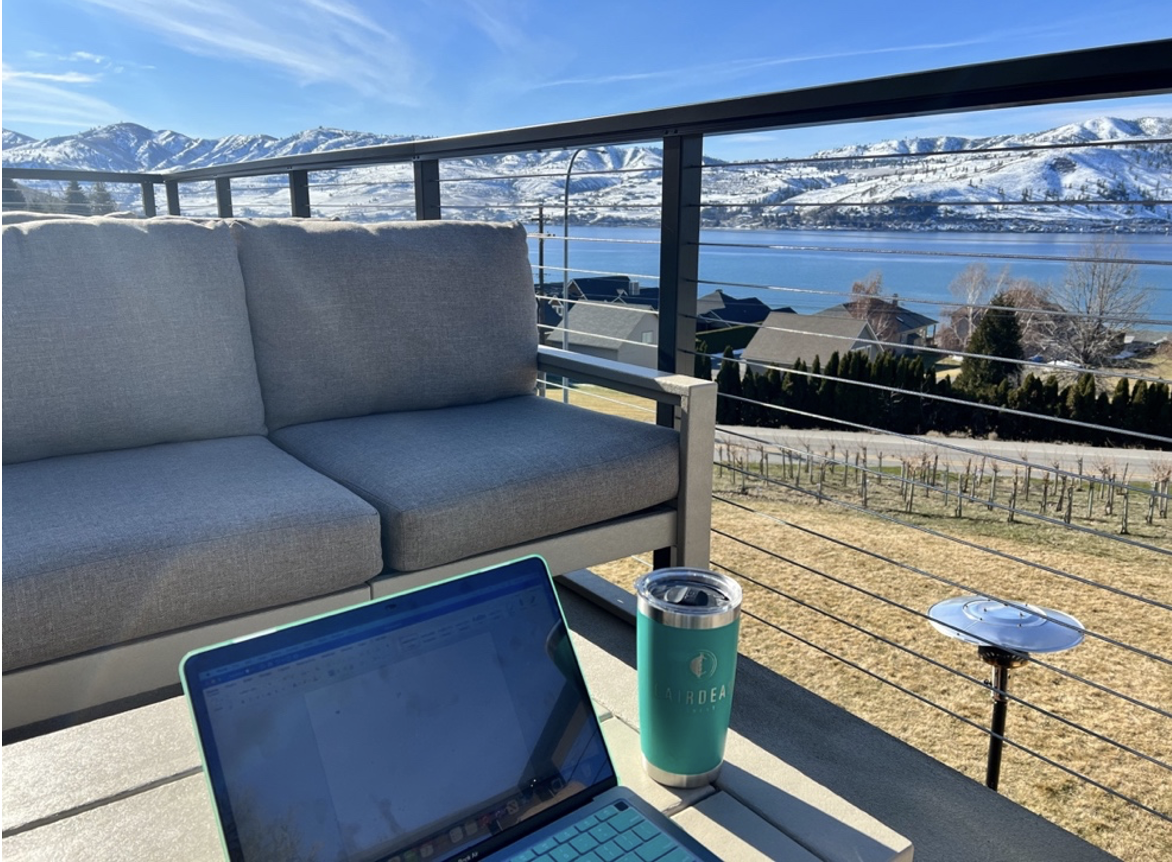
The Beginning: Pruning
The soil is warming and dormancy season is coming to an end which means it’s time to get out in the vineyards and prune, which not only sets this season up for success but future seasons as well. It’s quite the difference to go from following field crews on a 4wheeler and counting buds across 1000 acres to actually being the one pruning. It was quite peaceful. And have I mentioned the gorgeous weather?? Who else feels like they come alive as Spring starts to hit?
Although we source many of our grapes from Lawrence and Boushey vineyards, the three estate Rhone varietals that we do have are extremely unique. Clairette Blanche is used for sparkling wine, head trained/gobelet Syrah for single varietal red wine, and Picardan for single varietal white wine. While I’ve worked with Syrah before, head trained is new for me as well as the two whites.
In fact, Cairdeas is 1 of 5 vineyards in the entire US that has Picardan (the only in Washington, the others are in California and Texas) so not many people work with or taste it! Used as a rare blending grape in Châteauneuf-du-Pape, there’s only about 2 acres remaining there.
Pruning is necessary every year, as every cane has buds the entire length and leaving too many would throw off the vine balance. We leave 3 buds per spur, which allows us the opportunity to go back and shoot thin if we see necessary, but ideally allows us the right amount of fruit for concentrated flavors and ripening without being too much or too little vigor for the vine. Again-balance. Pruning also allows future spur positions to be set up in the most efficient way possible which is important when training young vines. Other than an overnight dump of 2 feet of snow and a few days of single digit temps, we had no cold events to cause worry about bud damage. Cold damage can be quickly assessed by cutting a cross-section of a bud and visually checking for green tissue.
I am absolutely loving each of these estate varietals that I got to harvest and help make into wine, but I never got to be a part of their growing season, so being out there as we bring in the 2022 vintage feels so special. It’s also been fun to have the instant gratification of the ready to drink Picardan, the excitement of inoculating the Clairette base wine for sparkling later this month, and the patience for the Syrah sleeping in barrel for another year.
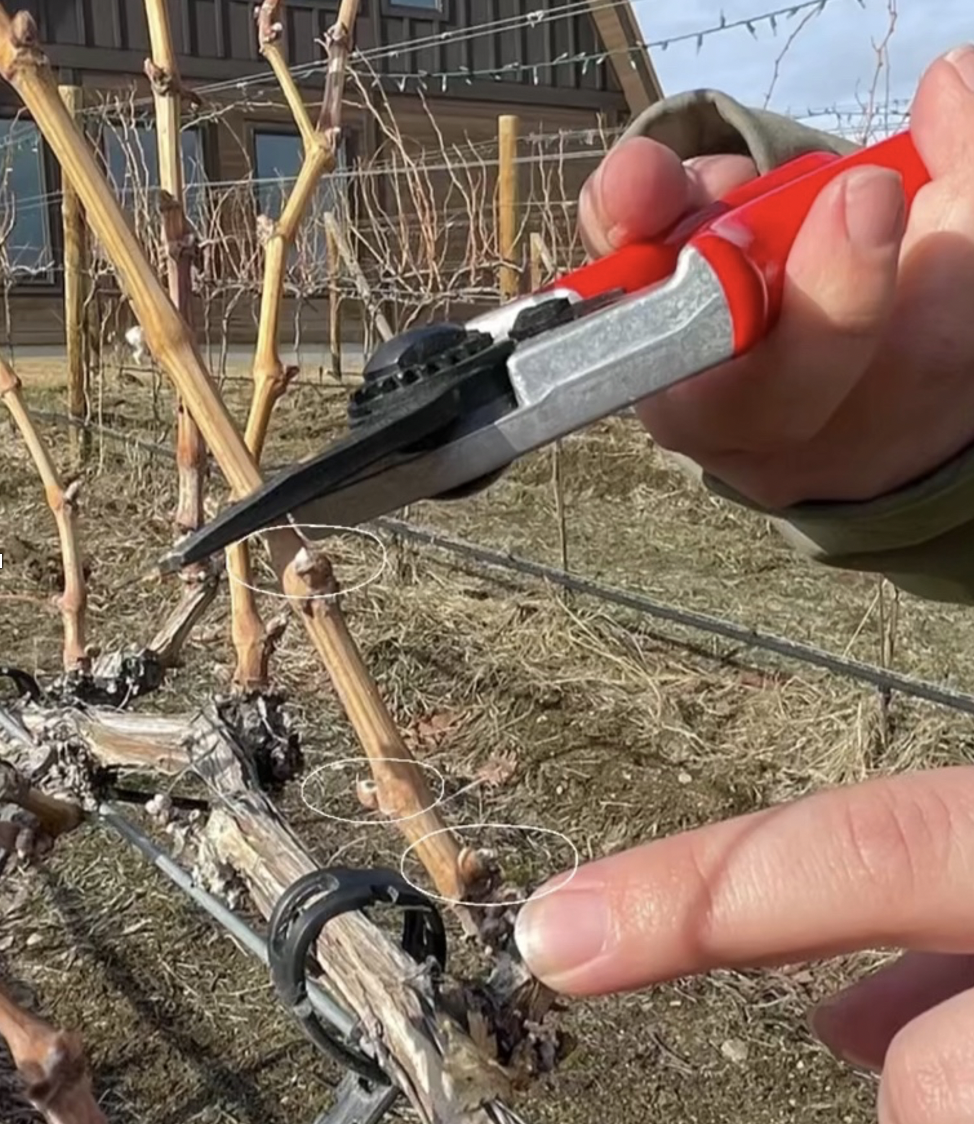
The End: Blending
Speaking of estate Syrah sleeping in barrel, this month we’ve finally worked through all of the 2020 blend creations as we prepare for our upcoming bottling day. Just another reason why pruning is so exciting, I’m getting to taste the fruit from the estate block picked 18 months ago, while also spending the afternoons with the beginning of the upcoming vintage.
I’ve always been a technical, science based, analytical person… which doesn’t translate well to having a creative side. People always say winemaking is a mix of art and science so luckily I get to find a way to combine both in a way that fits me- and blending is when we get to make our final art piece.
One of my favorite examples of blending from this month is when we were hammering out our Tri- a typical GSM blend. Glass after glass we kept making a little tweak, hoping that change would influence the mid-palate or this one would add a little more spice. It’s easy to think, “Oh you have 3 wines (Grenache, Syrah, Mourvèdre) you just mix them together” but that’s not the case.
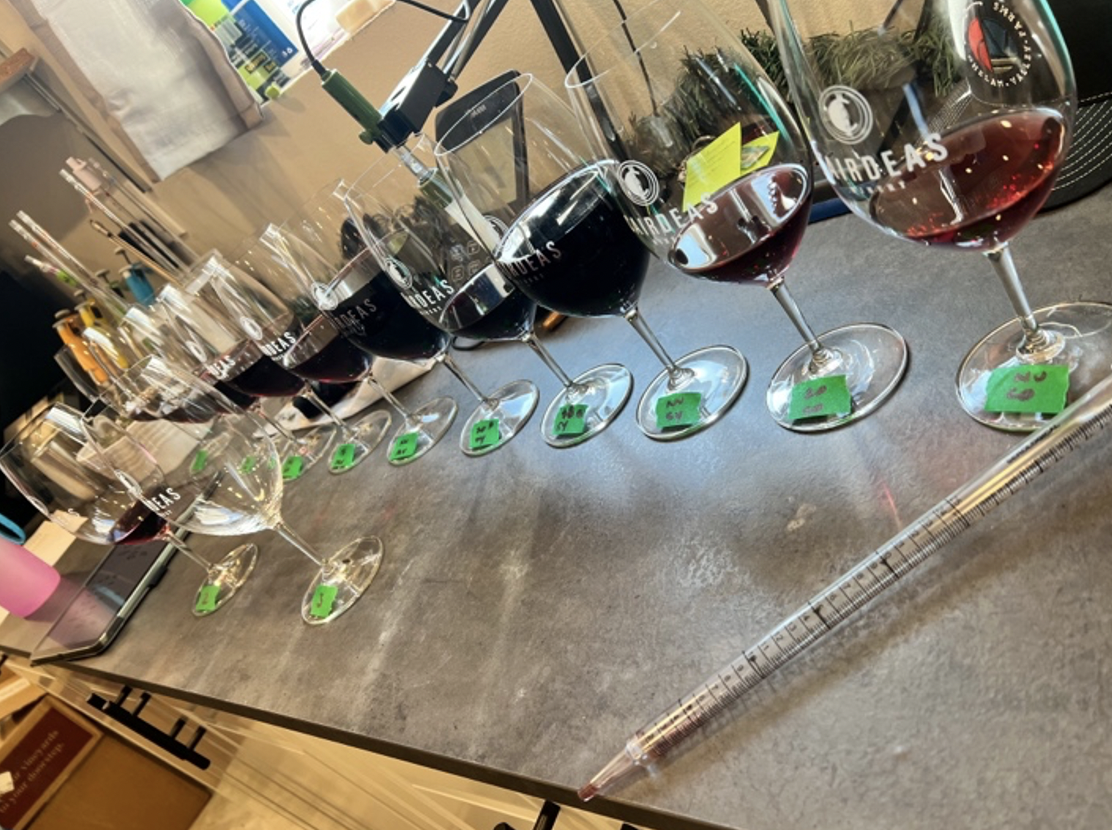
After the initial racking, we return every individual barrel to the one it came from… which makes a huge difference! It leaves each barrel as a unique player instead of homogenizing the entire Syrah lot into one uniform piece. But that also doesn’t just mean it’s as straightforward as Syrah in French vs American oak, it gets so much deeper than that. It’s new French or American, once filled French or American, neutral French or American, once filled American but two different Coopers. Syrah from Boushey but maybe that other Syrah from Meek has just the missing element we’re looking for.
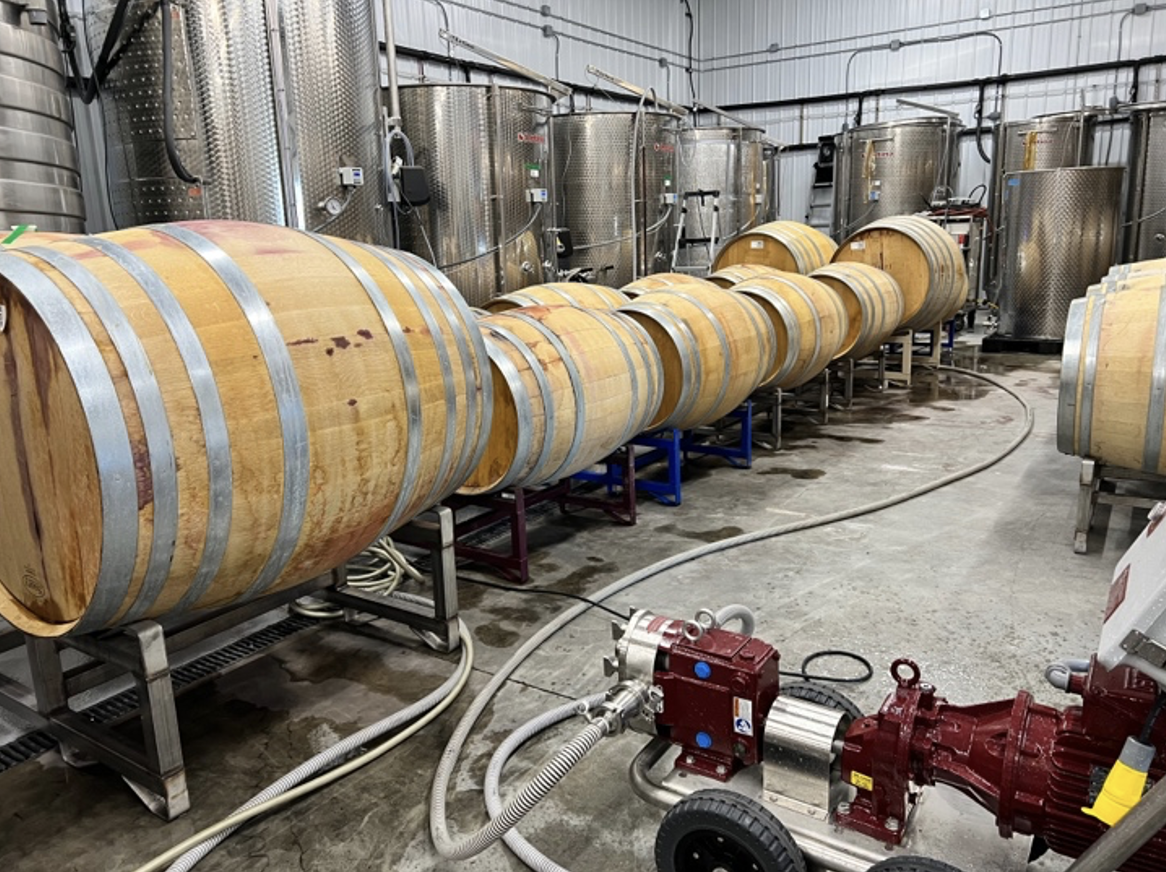
My boss compared blending our Tri to being an artist- as you can see in the we don’t just have three “colors” in front us and expect to make a painting, we have 12+ and combine them in different ways to create the final picture. I don’t think a lot of consumers really comprehend how intensive blending can be (or the entire winemaking/ viticulture process which again why this program is so cool) and how nitty-gritty we get with every decision to create the best wine.
There are so many reasons why moving to a small winery has been beneficial for me- working with so many different coopers and barrel styles (and all of the tasting that comes with that) has really helped me develop my own preferences as I work on my own projects. And now that this last big winemaking task has been completed and the barrels are empty, we count down to bottling day!
El Principio y el Fin del Proceso de Elaboración del Vino
No puedo creer que ya hayan pasado 8 meses en mi nuevo hogar desde la entrevista inicial. Cuando digo hogar, puedo sentir en mi alma que aquí es donde debo estar. Salió el sol, y finalmente por un día la temperatura alcanzó los 50 grados (trato de no mirar la temperatura más cálida en el valle de Yakima, donde vivía y trabajaba), y estoy disfrutando de mi vista favorita mientras reflexiono en los últimos meses. En mi entrevista inicial, hablé mucho sobre querer ser parte de todo el proceso, desde el brote hasta la botella, y definitivamente puedo decir que voy a lograrlo. De hecho, este mes ha sido precisamente eso: brotes y {casi} botellas.

El comienzo: la poda
El suelo se está calentando y la temporada de latencia está llegando a su fin, lo que significa que es hora de salir a los viñedos y podar, lo que no solo prepara esta temporada para el éxito, sino también las futuras. Es una gran diferencia pasar de seguir a los equipos de campo en un vehículo de cuatro ruedas y contar los brotes en 1000 acres a ser realmente el que poda. Fue bastante pacífico. ¿Y ya mencioné el magnífico clima? ¿Quién más siente que cobran vida cuando la primavera comienza a llegar?
Aunque obtenemos muchas de nuestras uvas de los viñedos de Lawrence y Boushey, las tres variedades de Estate Rhône que tenemos son extremadamente únicas. Clairette Blanche se utiliza para vino espumoso, Syrah formado En Vaso para vino tinto monovarietal y Picardan para vino blanco monovarietal. Aunque he trabajado antes con Syrah, la formacion en Vaso y los dos vinos blancos son nuevos para mí. De hecho, Cairdeas es 1 de 5 viñedos en todo EE. UU. que tiene Picardan (el único en Washington, los otros están en California y Texas), por lo que no muchas personas trabajan con él o lo prueban. Utilizado como una uva de mezcla rara en Châteauneuf-du-Pape, solo quedan alrededor de 2 acres allí.
La poda es necesaria todos los años, ya que cada caña tiene brotes por toda la longitud y dejar demasiados alteraría el equilibrio de la vid. Dejamos 3 yemas por espuela, lo que nos da la oportunidad de volver y ralear si lo vemos necesario, pero idealmente nos permite la cantidad justa de fruta para sabores concentrados y maduración sin ser demasiado o muy poco vigor para la vid. De nuevo, equilibrio. La poda también permite establecer futuras posiciones de espuelas de la manera más eficiente posible, lo cual es importante cuando se trata del sistema de formación de vides jóvenes.
Aparte de una descarga nocturna de 2 pies de nieve y algunos días de temperaturas de un solo dígito, no tuvimos eventos fríos que causaran preocupación por el daño de los cogollos. El daño por frío se puede evaluar rápidamente cortando una sección transversal de un cogollo y comprobando visualmente si hay tejido verde.
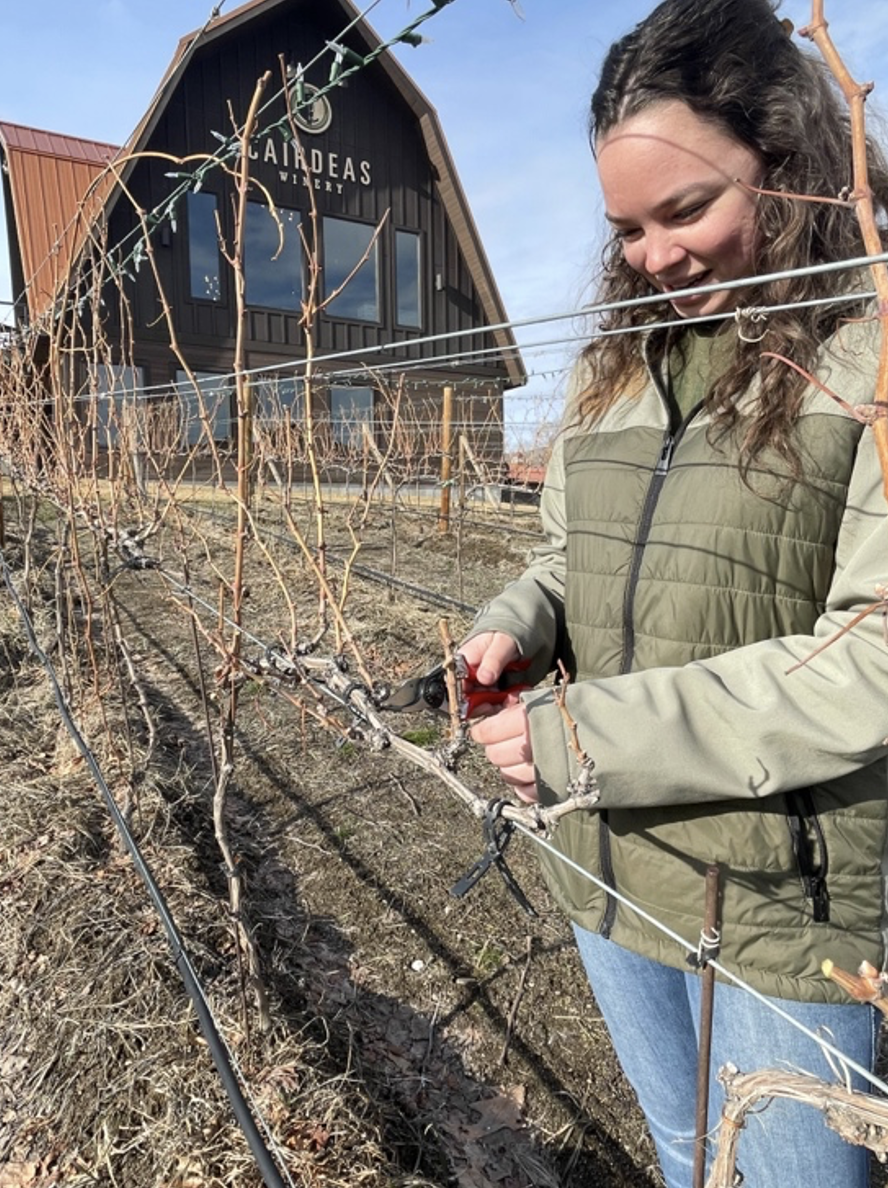
Me encanta cada uno de estos varietales de finca que pude cosechar y ayudar a convertirlos en vino, pero nunca pude ser parte de su temporada de crecimiento, así que el poder estar allí mientras traemos la cosecha 2022 se siente tan especial. También ha sido divertido tener la gratificación instantánea del Picardan que está listo para beber, la emoción de inocular la base del vino Clairette para espumosos a fines de este mes y la paciencia del Syrah que dormirá en barrica por otro año.
El fin: Mezclar
Hablando de la finca Syrah durmiendo en barrica, este mes finalmente hemos trabajado en todas las creaciones de mezclas de 2020 mientras nos preparamos para nuestro proximo embotellado. Solo otra razón por la cual la poda es tan emocionante, puedo probar la fruta del bloque de la finca cosechada hace 18 meses, mientras paso las tardes con el comienzo de la próxima cosecha.
Siempre he sido una persona analítica, técnica y basada en la ciencia, lo que no se traduce bien en tener un lado creativo. La gente siempre dice que la elaboración del vino es una mezcla de arte y ciencia, así que afortunadamente puedo encontrar la manera de combinar a ambos de manera que me quede bien. La mezcla es la parte final en la cual llegamos a hacer nuestra obra de arte.
Uno de mis ejemplos favoritos de combinación de este mes es cuando elaboramos nuestro Tri, una combinación típica de GSM. Copa tras copa, hacíamos un pequeño ajuste, con la esperanza de que el cambio influyera en el paladar medio o que esta agregara un poco más de sabor. Es fácil pensar: “Oh, tienes 3 vinos (Grenache, Syrah, Mourvèdre), solo los mezclas”, pero ese no es el caso.

Después del trasiego inicial, regresamos el vino a su lugar de donde vino inicialmente, ¡lo que hace una gran diferencia! Deja cada barrica como un jugador único en lugar de homogeneizar todo el lote de Syrah en una sola pieza uniforme. Pero eso tampoco significa que sea tan sencillo como el Syrah en roble francés comparado al roble americano, es mucho más profundo que eso. Es nuevo francés o americano, primer uso francés o americano, neutral francés o americano, primer uso americano, pero por dos Toneleros diferentes. Syrah de Boushey, pero tal vez ese otro Syrah de Meek tenga justo el elemento que estamos buscando.

Mi jefe comparó el mezclar nuestro Tri con ser un artista, como puede ver en la fotografía no solo tenemos tres “colores” frente a nosotros esperando crear una pintura, tenemos más de 12 y los combinamos de diferentes maneras para crear el cuadro final.
No creo que muchos consumidores realmente comprendan cuán intensa puede ser la mezcla (o todo el proceso de vinificación/viticultura, que nuevamente es la razón por la cual este programa es tan genial), y cuán meticulosos nos hacemos con cada decisión para crear el mejor vino.
Hay tantas razones por las que mudarme a una bodega pequeña ha sido beneficioso para mí: trabajar con tantos tipos de tonelería y barricas diferentes (y toda la degustación que conlleva) realmente me ha ayudado a desarrollar mis propias preferencias a medida que trabajo en mis propios proyectos. Y ahora que esta última gran tarea de vinificación se ha completado y las barricas están vacías, ¡comenzamos la cuenta regresiva para el día del embotellado!
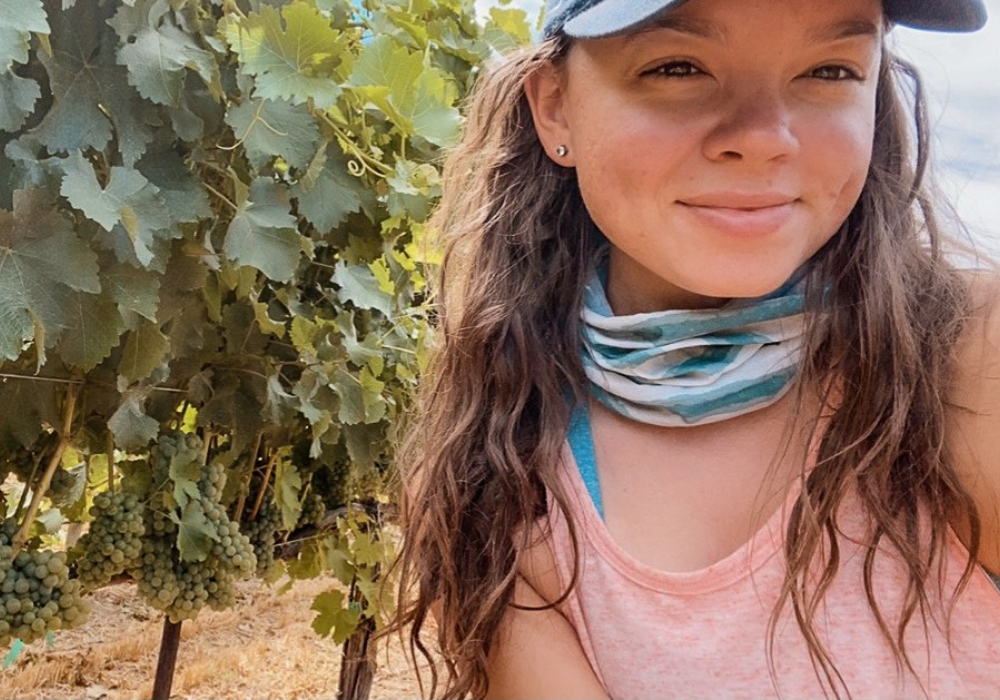

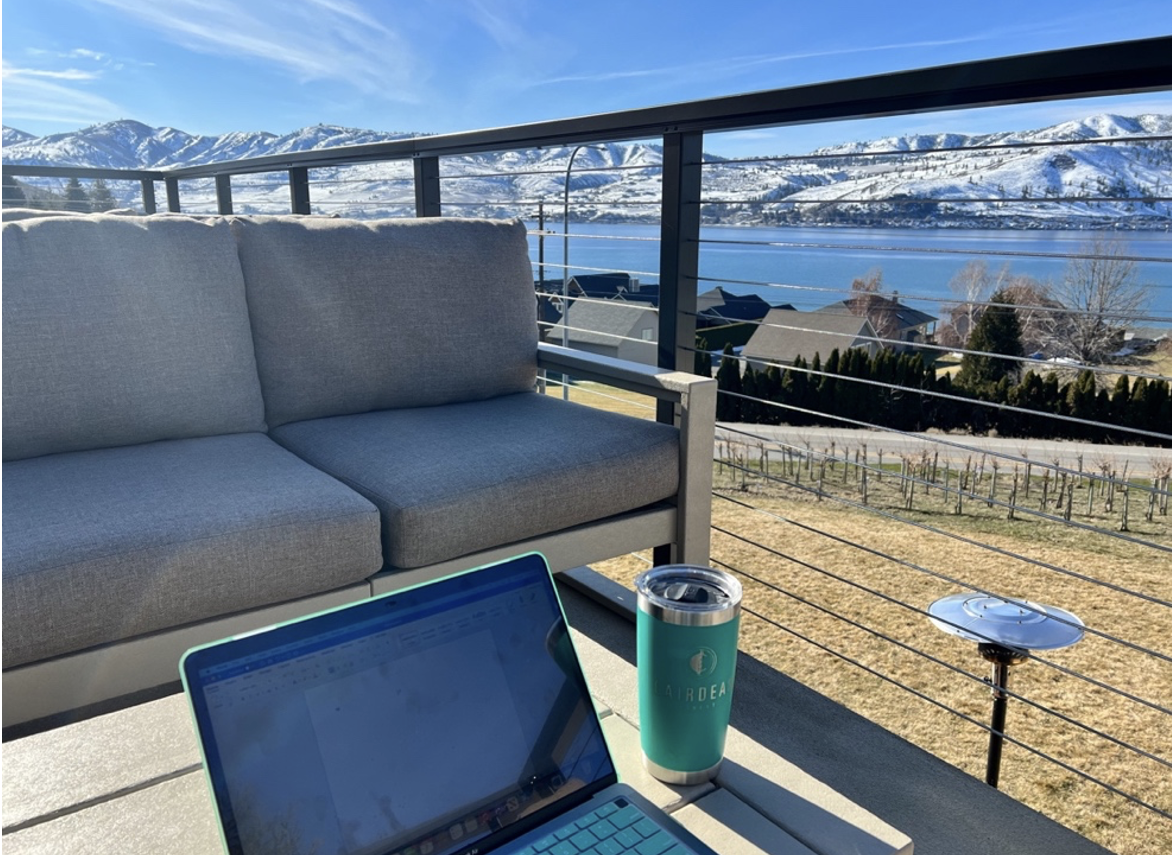
Join the Conversation